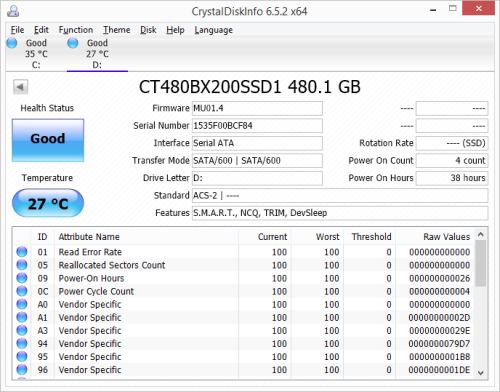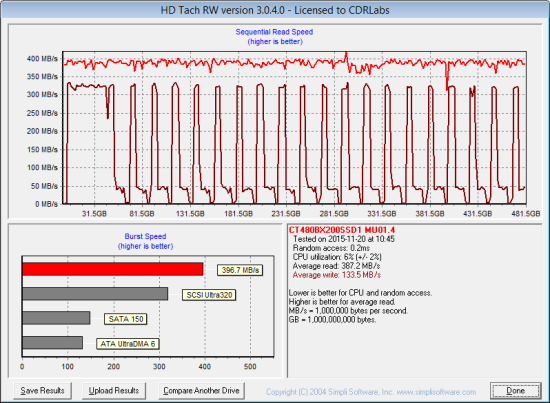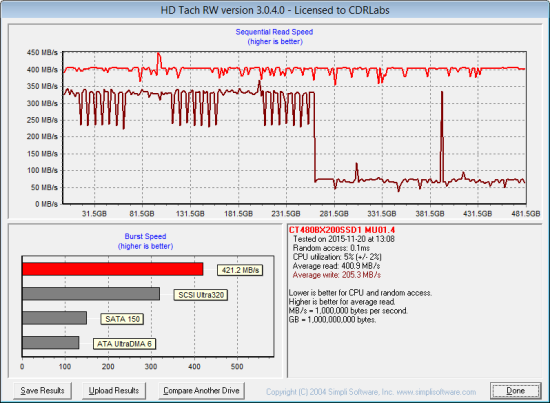TRIM Performance:
While SSD's offer many benefits, there are some downsides to using flash memory. One of the biggest issues people run into is performance degradation. Over time, an SSD will run out of fresh blocks and will have to write over data the file system has marked as deleted. This procedure is very complicated and can slow an SSD's write speeds considerably.
To fix this problem, most manufacturers have added TRIM support to their SSDs. The TRIM command allows an operating system, such as Windows 7, to tell an SSD which data blocks are no longer in use. Using this information, the drive pro-actively erases these blocks and adds them to the free block pool.

To test the BX200's TRIM and garbage collection functions, I first put the drive in a "dirty" state. I used Iometer to fill the entire drive and then ran a random write test for 30 minutes. This had little impact on the BX200's read speed. However, its average writing speed dropped to 133.5 MB/s.

Crucial BX200 - Dirty
To see how well the BX200 could recover, I let the computer sit for about an hour and then reran the test. The drive wasn't able to reach the factory fresh performance shown in our earlier tests. However, its average write speed climbed up to 186.4 MB/s.

Crucial BX200 - After TRIM
Lastly, I used Crucial's Storage Executive software to perform a secure erase (aka sanitize) on the BX200. With the drive wiped clean, it had average read and write speeds of 400.9 MB/s and 205.3 MB/s, respectively.

Crucial BX200 - Secure Erased
Final Thoughts:
While not Crucial's fastest or most feature packed SSD, the BX200 is an easy and affordable way for consumers to improve the performance of their existing desktop or notebook computer. The BX200 combines Silicon Motion's SM2256 controller with Micron's new 16nm TLC NAND to deliver substantial performance gains and lower power consumption than a typical hard drive. In our sequential read and write tests, the 480GB version of the drive was able to read at speeds as high as 560 MB/s and write at speeds in excess of 461 MB/s. It also performed fairly well when doing random reads, but lagged behind other drives in our random write tests, producing a little more than 25,000 IOPS at low queue depths.
Like most TLC-based SSDs, the BX200 does have its limitations. To compensate for the slow write speeds typically associated with this type of NAND, the drive employs what Crucial calls SLC Write Acceleration. Under normal workloads, SLC Write Acceleration does a great job of maintaining peak performance. However, once a consecutive write operation exceeds the size of the SLC cache and you make the transition to TLC NAND, the BX200's write speed drops considerably. It's unlikely that you will ever run into this situation if your computer is used primarily for web browsing or word processing, but, if you have heavier workloads, you may want to consider Crucial's MX200 SSD.
The BX200 is available now in 240GB, 480GB and 960GB capacities. Prices on Amazon.com currently range from $85 up to $300, with the 480GB version reviewed here going for about $149.
Highs:
- Available in 240GB, 480GB and 960GB capacities
- Good sequential and random read and write performance
- Performs equally well with compressible and incompressible data
- SATA 6Gb/s interface
- Supports TRIM, SMART and active garbage collection
- DEVSLP power mode
- Ultra-slim form factor
- Works with Crucial's Storage Executive software
- Includes 9.5mm spacer and data migration software key
- 3 year warranty
- Affordably priced
Lows:
- Mediocre random write performance
- Write speed drops when SLC cache is full
- Does not support hardware based encryption

